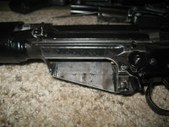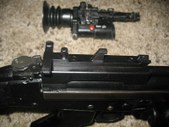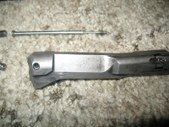
1
Canadian C1A1 (Ex-OPP) with bayonet.
British L1A1 (Century Parts gun)
Indian 1A1
| 
2
Starting with the 1A1.
Purchased for "Parts" a number of years ago due to long (but not quite NOGO headspace and overall condition.)
I cleaned up and sanded down the wood about 10 years ago, giving it several layers of varnish. Yes, I know, I "ruined" it, but if you saw the wood before I started, it was a good investment of my time.
The metal is well worn, the bluing on the barrel is essentially non-existant.
| 
3
Left side view, same rifle.
| 
4
Here you can see the typical receiver markings.
|

5
There is a stamping here inside that does not correspond to any other numbers on the rifle.
Also, you can see where I installed an extended pin in the magazine catch, resulting in a last round hold-open for this rifle.
I used to shoot this rifle in service rifle competition, so the last round hold open was somewhat handy for me.
| 
6
Field Stripped.
| 
7
A bit of a close-up view of the "working bits."
You can see the 1-piece firing pin, and the sand cuts in the bolt carrier.
| 
8
Underside of the bolt carrier, and the other side of the bolt, note the serial number electro-penciled into it.
|

9
Inside of the reciever, showing the tooling marks. Kinda rough.
| 
10
Forward view into the receiver.
| 
11
Right hand side view. Note the date marking on the upper receiver, RFI 1971 (Rifle Factory Ishapore)
Also, you can see some of the original painted on finish on the butt-socket.
| 
12
Now we move on to the L1A1. It's one of the Century rifles that was sold in 1992, a mish-mash of parts assembled from guns that were sold as surplus.
I also shot this rifle in Service Rifle Competition, and replaced the original British Backsight with a C1 backsight. I have the original alongside it. You can also see the Sight Unit Infantry Trilux (SUIT) on an original mount.
|

13
Close-up view of the SUIT, you can see the NSN, as well as the flip-lever for changing from 200 to 400 yard ranges. The windage knob is also visible here.
| 
14
You can see here some of the original black paint finish.
| 
15
Left hand side of the receiver. You can see the paint is well peeled/cracked off, and yo ucan also see the mishmash of upper and lower parts.
For the record, it is the serial number on the UPPER receiver of the FN that is to be on the registration certificate. I had to get that corrected on mine.
| 
16
Same view here as shown on the Indian rifle, but no marks stamped inside the magazine well. No idea what they meant on the Indian rifle.
You can also see the modified Bolt Hold Open pin, a simple piece of 1/8" diameter brass rod was all it took me. Yes, the purists will scream that it's not original, but it was what I needed for the competitions I was shooting.
|

17
A close-up view of the Left side of the SUIT sight.
| 
18
Top view of the SUIT.
The round dot in the center is where the Trilux lamp would have been. It was not present with this sight, I got a little LED thingie with it instead.
Note on the right side of the picture a "E-D" for Elevate or Drop, that's how the elevation is controlled.
| 
19
Focusing here on the latch with it's fancy S-Spring. Here it is closed.
| 
20
And here is the latch in the open position, allowing the sight to be removed. Truly a "Quick Detach" system.
|

21
And here is the mount. You can see the tab in the center that the locking spring hooks up against, with the v-notch in the front for alignment, and the post at the rear for windage adjustment.
| 
22
Here is the bottom of the sight. YOu can see the sight was last serviced in 1991, not too bad!
YOu can see the windage adjustment system, the bar with the U-notch in it, and the spring for locking it into place.
| 
23
Here's the bolt from the L1A1, note the two-piece firing pin, and the much shorter firing pin spring.
| 
24
Here you can see the crossed flags on the right hand side of the bolt. (British Army Acceptance? It's electropencilled on.)
|
